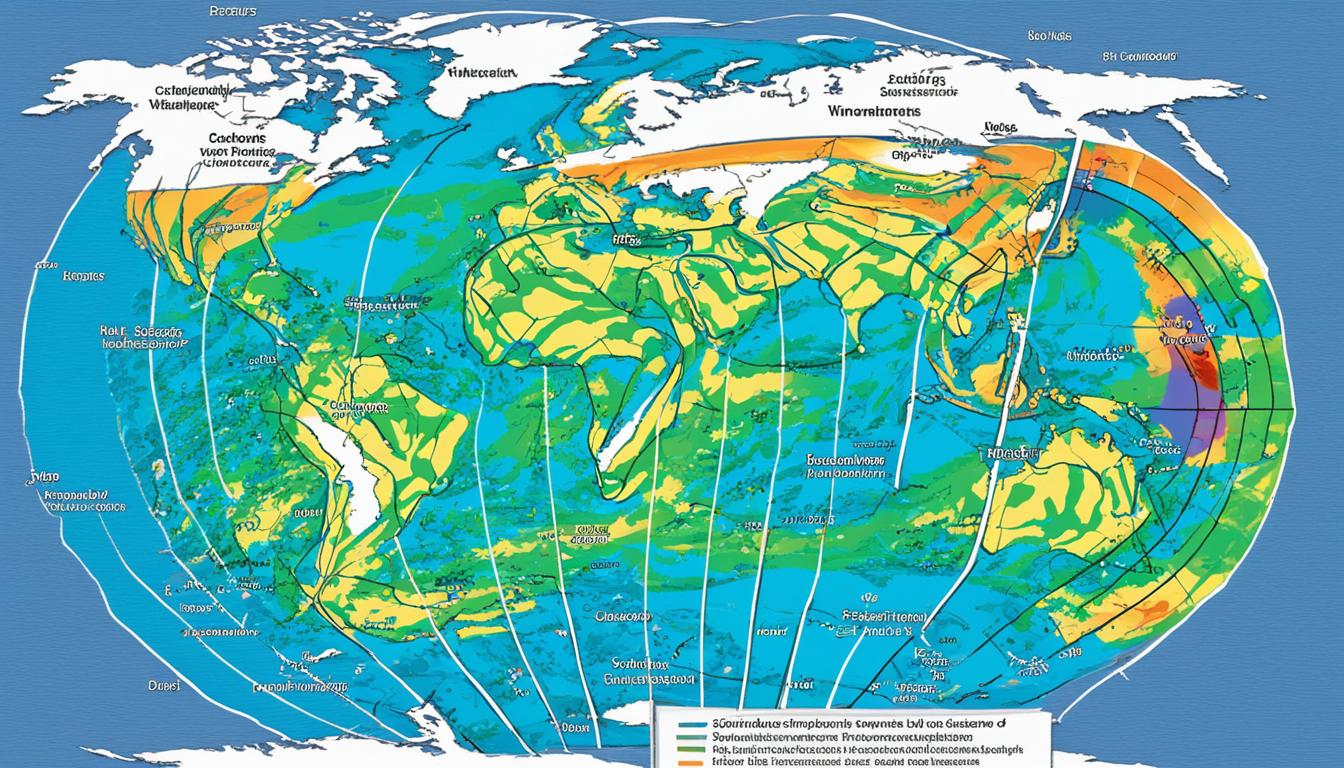Welcome to our comprehensive guide on the science of weather forecasting. In this article, we will provide a detailed understanding of the mechanisms and processes that enable meteorologists to predict weather patterns and provide accurate forecasts. By delving into the science behind weather forecasting, we aim to equip you with the knowledge to better comprehend and appreciate the complexities of this crucial field.
Weather forecasting involves the analysis of intricate atmospheric conditions, the use of advanced technology for data collection, and the application of computer models to simulate and predict future weather events. By exploring these key aspects, we will unravel the inner workings of weather forecasting and shed light on the techniques used to improve the accuracy of forecasts.
Understanding the science behind weather forecasting not only enhances our appreciation for the field but also empowers us to make informed decisions based on weather predictions. Whether you’re a farmer planning agricultural activities, a traveler preparing for a trip, or an emergency management professional coordinating disaster response, accurate weather forecasts play a pivotal role in ensuring safety, minimizing risks, and optimizing resource allocation.
Join us as we embark on a journey to explore the science, technology, and techniques that drive weather forecasting. By the end of this article, you will have a deeper understanding of the invaluable role weather forecasts play in our lives and gain insight into the advancements and future directions of this ever-evolving field.
The Role of Atmospheric Conditions in Weather Forecasting
Weather forecasting relies heavily on analyzing and interpreting atmospheric conditions. These conditions, including air pressure, temperature, humidity, and wind patterns, provide valuable insights into the behavior and development of weather patterns. By monitoring and understanding these factors, meteorologists can make accurate predictions about future weather events.
Let’s take a closer look at how each of these atmospheric conditions influences weather forecasting:
Air Pressure
Air pressure, also known as atmospheric pressure, refers to the force exerted by the weight of the air above a given point on Earth’s surface. Changes in air pressure indicate the approaching or departure of weather systems. High-pressure areas typically correlate with fair and dry weather, while low-pressure areas often bring cloudy or stormy conditions.
Temperature
Temperature plays a crucial role in weather forecasting as it affects the density and movement of air. Meteorologists analyze temperature variations to identify frontal boundaries, determine the likelihood of precipitation, and make predictions about weather patterns. Understanding temperature patterns helps forecasters anticipate temperature extremes and monitor temperature-related phenomena such as heatwaves or cold snaps.
Humidity
Humidity refers to the amount of water vapor present in the air. Moisture content in the atmosphere impacts cloud formation, precipitation, and overall weather conditions. Meteorologists measure humidity levels to assess the potential for fog, rain, or snow, as well as to analyze the stability and moisture content of the air mass influencing a specific region.
Wind Patterns
Wind patterns play a crucial role in weather forecasting as they transport heat, moisture, and air masses across different regions. By tracking wind speed and direction at various altitudes, meteorologists can gain insights into the movement and strength of weather systems. Understanding wind patterns helps forecasters predict the trajectory of storms, track the formation of tropical cyclones, and analyze the behavior of atmospheric disturbances.
By closely monitoring these atmospheric conditions and their interplay, meteorologists can make informed decisions about weather forecasting. Advanced techniques and technologies enable them to collect and analyze data, refine prediction models, and improve the accuracy of weather forecasts.
To illustrate the complexity of analyzing atmospheric conditions in weather forecasting, take a look at the image below:
As meteorologists continue to enhance their understanding of atmospheric conditions and refine forecasting techniques, we can expect even more accurate predictions and timely warnings for severe weather events.
Technology and Data Collection in Weather Forecasting
Weather forecasting relies on advanced technology and comprehensive data collection to provide accurate predictions. Meteorologists utilize a range of tools and instruments to gather and analyze data, enabling them to generate precise weather forecasts.
One of the primary technologies used in weather forecasting is weather satellites. These satellites orbit the Earth and capture valuable data, including cloud cover, temperature, humidity, and wind patterns. The data collected by weather satellites helps meteorologists monitor weather conditions globally and track the development of storms and weather systems.
Radar systems also play a crucial role in data collection for weather forecasting. Weather radars use radio waves to detect precipitation, such as rain, snow, and hail. By analyzing the returns of these radio waves, meteorologists can determine the intensity, movement, and structure of weather systems. This information is vital for predicting severe weather events and issuing timely warnings to the public.
Weather stations are another essential component of data collection in weather forecasting. These stations are equipped with various sensors that measure parameters like temperature, atmospheric pressure, humidity, and wind speed. Weather stations are strategically located across different regions, providing meteorologists with localized data, which improves the accuracy of weather forecasts.
The extensive collection of data doesn’t end there. Meteorologists also incorporate data from various other sources, such as ocean buoys, weather balloons, and ground-based instruments. By combining data from different sources and utilizing advanced analysis techniques, meteorologists can generate comprehensive weather models that provide detailed forecasts.
The continuous advancements in technology and data collection methods have revolutionized weather forecasting. These advancements have not only improved the accuracy of forecasts but also enhanced our understanding of weather patterns and their impacts. With access to vast amounts of data, meteorologists can monitor and analyze weather conditions in real-time, allowing for timely and informed predictions that help communities prepare and mitigate potential risks.
Computer Models and Weather Prediction
Computer models play a crucial role in weather prediction, enabling meteorologists to forecast future weather conditions with a high level of accuracy. In this section, we will delve into the mathematical algorithms and models used to simulate and predict weather patterns.
Meteorologists input vast amounts of data into these models, including atmospheric conditions, historical weather data, and real-time observations. Through complex calculations and simulations, these computer models generate forecasts that help us anticipate weather events.
One of the key advantages of computer models is their ability to analyze and interpret data on a global scale. They take into account a multitude of factors, such as temperature, air pressure, humidity, wind patterns, and ocean conditions, to create a comprehensive understanding of the Earth’s atmosphere.
By running simulations based on these inputs, meteorologists can predict how atmospheric conditions may change over time. They can then translate this information into weather forecasts, providing valuable insights into upcoming weather patterns.

Computer models have significantly enhanced our understanding of weather patterns and improved the accuracy of weather forecasts. However, it is important to note that there are limitations and challenges associated with computer-based weather forecasting.
Factors such as the complexity of atmospheric dynamics, uncertainties in data inputs, and the need for ongoing model refinements pose challenges to meteorologists. Therefore, while computer models are powerful tools, forecasters rely on their expertise and experience to interpret and validate the output of these models.
Despite the challenges, computer models continue to evolve and improve, integrating advancements in technology and scientific research. As we better understand weather patterns and refine our forecasting techniques, we move closer to even more precise and reliable weather predictions.
Forecasting Techniques and Accuracy
The accuracy of weather forecasting has significantly improved over the years due to advancements in technology and the implementation of various forecasting techniques. In this section, we will explore the different methods employed by meteorologists to predict weather conditions with increasing accuracy and reliability.
The first technique we’ll discuss is numerical weather prediction. This method involves utilizing mathematical models and computer algorithms to simulate atmospheric conditions and predict future weather patterns. By inputting vast amounts of data, including current atmospheric conditions and historical weather patterns, meteorologists can generate forecasts that take into account factors such as temperature, humidity, wind patterns, and air pressure.
Another technique used in weather forecasting is ensemble forecasting. This approach involves running multiple simulations with slight variations in initial conditions to account for the inherent uncertainty in weather prediction. By analyzing the different outcomes of these simulations, meteorologists can estimate the range of possible weather scenarios and better assess the level of confidence in their forecasts.
Analog forecasting is another valuable technique that relies on historical weather data to predict similar weather patterns in the future. Meteorologists identify past weather events that closely resemble the current conditions and use them as analogs to forecast the expected weather. This method is particularly useful in situations where numerical models may struggle to accurately capture specific atmospheric dynamics.
Improving the accuracy of weather forecasts is an ongoing endeavor for meteorologists. They constantly refine their techniques by incorporating new data sources, enhancing modeling algorithms, and incorporating real-time observations from weather stations, satellites, and remote sensing technologies. These efforts aim to provide more precise and timely weather forecasts, thereby enabling individuals, businesses, and communities to make informed decisions and take appropriate actions.
The Importance of Weather Forecasting
Weather forecasting is of paramount importance in various sectors, playing a critical role in shaping our daily lives. Accurate weather forecasts have a significant impact on agriculture, transportation, emergency management, and planning. They enable individuals, communities, and the economy to make informed decisions and safeguard their well-being.
The accurate prediction of weather conditions allows agricultural communities to plan their farming activities effectively. Farmers rely on weather forecasts to determine the optimal time to plant and harvest crops, manage irrigation, and protect their livelihoods from weather-related risks. By staying ahead of weather patterns, farmers can mitigate the impact of adverse weather conditions and maximize their productivity.
In the transportation sector, weather forecasts are instrumental in ensuring safe and efficient travel. Airlines, shipping companies, and ground transportation services rely on accurate forecasts to assess potential disruptions caused by severe weather events. By anticipating weather conditions such as storms, heavy fog, or icy roads, transportation providers can adjust their schedules, reroute if necessary, and minimize the risk of accidents or delays.
Weather forecasting also plays a crucial role in emergency management and disaster preparedness. By accurately predicting severe weather events like hurricanes, tornadoes, or blizzards, meteorologists provide essential information for evacuation plans and emergency response strategies. Timely and reliable forecasts help authorities mobilize resources, issue warnings, and coordinate rescue operations, thereby saving lives and reducing the impact of natural disasters.
The importance of weather forecasting further extends to urban planning and infrastructure development. Architects and city planners rely on weather forecasts to design buildings, drainage systems, and transportation networks that can withstand prevailing weather conditions. Accurate forecasts enable them to make informed decisions about flood control measures, building codes, and the placement of critical infrastructure, ensuring the resilience and sustainability of communities.
The economic impact of accurate weather forecasting cannot be overstated. By anticipating weather-related risks and opportunities, businesses can optimize their operations, logistics, and supply chains. Retailers can adjust their inventory based on expected weather conditions, and energy companies can plan for fluctuations in demand resulting from temperature changes. In addition, financial markets rely on accurate weather forecasts to guide investments in sectors such as agriculture, energy, and insurance.
In conclusion, weather forecasting plays a vital role in countless aspects of our lives. From agriculture and transportation to emergency management and economic planning, accurate weather forecasts empower individuals, communities, and industries to make proactive decisions, mitigate risks, and ensure the safety and well-being of populations. Reliable weather forecasts are the backbone of resilience and sustainable development in our ever-changing world.
Advancements and Future Directions in Weather Forecasting
The field of weather forecasting is constantly advancing, thanks to ongoing developments in technology and scientific understanding. These advancements have significantly improved the accuracy and reliability of weather forecasts, allowing for better decision-making and risk mitigation in various sectors.
One major area of advancement is the development of improved weather models. Meteorologists now have access to more sophisticated mathematical algorithms and computational power, enabling them to simulate and predict weather patterns with greater precision. These improved models take into account a wide range of atmospheric variables and factors, resulting in more accurate forecasts.
Enhanced data collection methods are also contributing to the advancements in weather forecasting. Weather satellites, radar systems, and ground-based weather stations are continually being upgraded and expanded, providing meteorologists with a wealth of data to analyze and interpret. This extensive and detailed data collection helps enhance the accuracy of weather forecasts and enables meteorologists to detect and track severe weather events more effectively.
Looking ahead, one of the future directions in weather forecasting is the integration of artificial intelligence (AI). AI has the potential to revolutionize weather prediction by leveraging machine learning algorithms to analyze vast amounts of data and identify complex patterns. This integration can further improve the accuracy and timeliness of weather forecasts, ultimately benefiting society by providing more reliable information for preparedness and planning.






